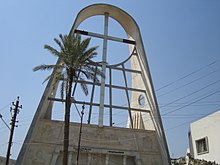2010 Baghdad church attack
| 2010 Baghdad church massacre | |
|---|---|

The cross of the Sayedat al-najat (“Our Lady of Salvation”) Syriac Catholic Church in Baghdad.
|
|
| Date | 31 October 2010, 17:00 – ~21:30 (UTC+4) |
| Target | The Sayidat al-Nejat (“Our Lady of Deliverance”) Syriac Catholic Church |
|
Attack type
|
Raid; hostage holding; killing due to religious ideas |
| Deaths | Two priests; 39–44 worshippers; 7–12 police/security; 5 bystanders; all (perhaps six) jihadi attackers |
|
Non-fatal injuries
|
78 |
| Perpetrators | Islamic State of Iraq |
Six suicide jihadis of a group formerly called Islamic State of Iraq attacked a Syrian Catholic church in Baghdad during Sunday evening Mass, on 31 October 2010, and started killing the worshipers, saying they were sending the Christians to "hell" and themselves to "heaven".
Hours later Iraqi commandos stormed the church, inducing the suicide jihadis to detonate their suicide vests. 58 worshipers, priests, policemen and bystanders were killed and 78 were wounded or maimed. World leaders and some Iraqi Sunni and Shi'ite imams condemned the massacre.
In late November 2010, Huthaifa al-Batawi, who was accused of master-minding the assault, was arrested along with 11 others in connection with the attack. During a failed attempt to escape in May 2011, Batawi and 10 other senior al-Qaeda militants were killed by an Iraqi SWAT team. On 2 August 2011, three other men were sentenced to death and a fourth to 20 years in prison in connection with the massacre. In 2012, an appeal court confirmed the sentences.
After the 19 March 2003 invasion of Iraq by a U.S.-led coalition aiming to destroy Iraq’s Ba'athist government of President Saddam Hussein, those occupying forces on 21 April 2003 installed their Coalition Provisional Authority (CPA) as provisional government over Iraq.
On 28 June 2004 the CPA installed the Iraqi Interim Government, consisting of Iraqis, and headed by Prime Minister Ayad Allawi, a Shia Muslim.
After the Iraqi parliamentary elections of December 2005, which saw a high turnout of 80%, a broad coalition government was formed consisting of the four largest parties: the Shi'ite National Iraqi Alliance (or United Iraqi Alliance), the Kurdish Democratic Patriotic Alliance of Kurdistan (DPAK), the Sunni Iraqi Accord Front (or Tawafuq) and the diverse Iraqi National List. This government was headed by Prime Minister Nouri al-Maliki, a Shia Muslim, and sworn in on 20 May 2006.
...
Wikipedia
